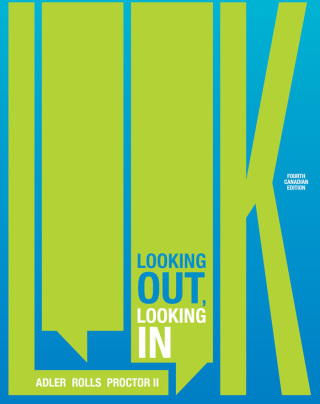Buy LOOK: Looking Out, Looking In, 4th Edition PDF ebook by author Adler, Rolls, Proctor II – published by Cengage Learning Canada Inc. in 2021 and save up to 80% compared to the print version of this textbook. With PDF version of this textbook, not only save you money, you can also highlight, add text, underline add post-it notes, bookmarks to pages, instantly search for the major terms or chapter titles, etc.
You can search our site for other versions of the LOOK: Looking Out, Looking In, 4th Edition PDF ebook. You can also search for others PDF ebooks from publisher Cengage Learning Canada Inc., as well as from your favorite authors. We have thousands of online textbooks and course materials (mostly in PDF) that you can download immediately after purchase.
Note: e-textBooks do not come with access codes, CDs/DVDs, workbooks, and other supplemental items.
eBook Details:
Full title: LOOK: Looking Out, Looking In, 4th Edition
Edition: 4th
Copyright year: 2021
Publisher: Cengage Learning Canada Inc.
Author: Adler, Rolls, Proctor II
ISBN: 9780176870980, 9780176881610
Format: PDF
Description of LOOK: Looking Out, Looking In, 4th Edition:
LOOK, Fourth Canadian Edition, weaves theory with popular culture and first-person accounts from diverse communicators to provide students with critical understanding of interpersonal communication. Now with even more opportunities for practical application, the fourth edition gives students the modeling and confidence to build communication skills in their own relationships, both in academia and in their future workplaces. Built with students in mind, LOOK 4Ce invites students from all programs of study to see the impact of communication skills on their everyday lives.
Table of Contents of LOOK: Looking Out, Looking In, 4th Edition PDF ebook:
CoverTitleCopyrightContentsContentsPart 1: Looking InChapter 1: A First Look at Interpersonal CommunicationWhy We CommunicatePhysical NeedsIdentity NeedsSocial NeedsPractical GoalsThe Process of CommunicationA Linear ViewA Transactional ViewCommunication Principles and MisconceptionsCommunication PrinciplesCommunication MisconceptionsThe Nature of Interpersonal CommunicationTwo Views of Interpersonal CommunicationPersonal and Impersonal Communication: A Matter of BalanceSocial Media and Interpersonal CommunicationBenefits of Social MediaChallenges of Social MediaCompetence in Social MediaWhat Makes an Effective Communicator?Communication Competence DefinedCharacteristics of Competent CommunicatorsCompetence in Intercultural CommunicationCommunication at WorkMetacommunicationChapter 2: Communication and Identity: Creating and Presenting the SelfCommunication and the SelfSelf-Concept and Self-EsteemBiological Roots of the Self-ConceptSocialization and the Self-ConceptCharacteristics of the Self-ConceptChanging Your Self-ConceptHow To Change Your Self-ConceptInfluences on IdentityThe Self-Fulfilling Prophecy and CommunicationSelf-Imposed PropheciesOther-Imposed PropheciesPresenting the Self: Communication as Identity ManagementPublic and Private SelvesCharacteristics of Identity ManagementThe Role of Identity ManagementWhy Manage Identities?How Do We Manage Identities?Identity Management and HonestyCommunication at WorkIdentity ManagementSelf-Fulfilling PropheciesSelf-EsteemChapter 3: Perception: What You See Is What You GetThe Perception ProcessSelectionOrganizationInterpretationNegotiationInfluences on PerceptionAccess to InformationPhysiological InfluencesPsychological ChallengesCultural DifferencesSocial RolesCommon Tendencies in PerceptionWe Judge Ourselves More Charitably than OthersWe Cling to First ImpressionsWe Assume that Others Are Similar to UsWe Are Influenced by the ObviousPerception CheckingElements of Perception CheckingPerception Checking ConsiderationsEmpathyCognitive ComplexityCognitive Complexity and CommunicationIncreasing Your Cognitive Complexity: The Pillow MethodCommunication at WorkEmpathyPerception and TeamworkChapter 4: Emotions: Feeling, Thinking, and CommunicatingWhat Are Emotions?Physiological FactorsNonverbal ReactionsCognitive InterpretationsVerbal ExpressionPrimary and Mixed EmotionsIntense and Mild EmotionsIntensity of EmotionsInfluences on Emotional ExpressionPersonalityCultureGenderSocial ConventionsSocial MediaEmotional ContagionGuidelines for Expressing EmotionsRecognize Your FeelingsRecognize the Difference between Feeling, Talking, and ActingExpand Your Emotional VocabularyExpress Multiple FeelingsConsider When and Where to Express Your FeelingsAccept Responsibility for Your FeelingsBe Mindful of the Communication ChannelManaging Difficult EmotionsFacilitative and Debilitative EmotionsSources of Debilitative EmotionsIrrational Thinking and Debilitative EmotionsMinimizing Debilitative EmotionsMaximizing Facilitative EmotionsCommunication at WorkPart 2: Looking OutChapter 5: Language: Barrier and BridgeUnderstandings and MisunderstandingsUnderstanding Words: Semantic RulesUnderstanding Structure: Syntactic RulesUnderstanding Context: Pragmatic RulesThe Impact of LanguageNaming and IdentityLanguage and SensitivityAffiliationPowerDisruptive LanguageFact-Opinion ConfusionFact-Inference ConfusionEmotive LanguageThe Language of Responsibility1. “It” Statements2. “But” Statements3. “I” and “You” Language4. “We” LanguageGender and Cultural Influences on LanguageGender and LanguageCulture and LanguageCommunication at WorkChapter 6: Nonverbal Communication: Messages beyond WordsCharacteristics of Nonverbal CommunicationNonverbal Communication DefinedNonverbal Skills Are VitalAll Behaviour Has Communicative ValueNonverbal Communication Is Primarily RelationalNonverbal Communication Occurs in Mediated MessagesNonverbal Communication Serves Many FunctionsNonverbal Communication Offers Deception CuesNonverbal Communication Is AmbiguousInfluences on Nonverbal CommunicationGenderCultureTypes of Nonverbal CommunicationBody MovementIndividual FactorsVoiceTouchAppearanceExternal FactorsPhysical SpacePhysical EnvironmentSmellTimeCommunication at WorkMaking Nonverbal Communication Work for YouChapter 7: Listening: More than Meets the EarListening DefinedHearing versus ListeningPassive ListeningActive ListeningElements in the Listening ProcessBarriers to ListeningTypes of Ineffective ListeningWhy We Don’t Listen BetterMeeting the Challenge of Listening BetterTypes of Listening ResponsesPromptingQuestioningParaphrasingSupportingAnalyzingAdvisingJudgingChoosing the Best Listening ResponseGenderCultureThe SituationThe Other PersonYour Personal StyleCommunication at WorkPart 3: Looking At RelationshipsChapter 8: Communication and Relational DynamicsWhy We Form RelationshipsAppearanceSimilarityComplementarityReciprocal AttractionCompetenceSelf-DisclosureProximityRewardsModels of Relational Development and MaintenanceDevelopmental ModelsDialectical PerspectivesConnection versus Autonomy (Independence)Openness versus PrivacyPredictability versus NoveltyManaging Dialectical TensionsCharacteristics of RelationshipsRelationships ChangeRelationships Are Affected by CultureRelationships Require MaintenanceRelationships Require CommitmentSocial SupportRepairing Damaged RelationshipsRelational TransgressionsStrategies for Relational RepairForgiving TransgressionsIntimacy in RelationshipsDimensions of IntimacyMasculine and Feminine Intimacy StylesCultural Influences on IntimacyIntimacy and Social MediaThe Limits of IntimacySelf-Disclosure in RelationshipsDegrees of Self-DisclosureA Model of Self-DisclosureBenefits and Risks of Self-DisclosureGuidelines for Self-DisclosureAlternatives to Self-DisclosureEquivocatingHintingThe Ethics of EvasionCommunication at WorkBoundaries and ProfessionalismBoundaries and Self-DisclosureRomance in the WorkplaceChapter 9: Improving Communication ClimatesCommunication ClimateLevels of Message ConfirmationHow Communication Climates DevelopDefensiveness: Causes and RemediesFace-Threatening ActsPreventing Defensiveness in OthersSaving Face and the Assertive Message FormatThe Assertive Message FormatNondefensive Responses to CriticismSeek More InformationAgree with the CriticCommunication at WorkChapter 10: Managing Interpersonal ConflictsThe Nature of ConflictConflict DefinedConflict Is NaturalConflict Can Be BeneficialConflict StylesAvoiding (Lose-Lose)Accommodating (Lose-Win)Competing (Win-Lose)Compromising (Partial Lose-Lose)Collaborating (Win-Win)Which Style to Use?Conflict in Relational SystemsComplementary, Symmetrical, and Parallel StylesDestructive Conflict PatternsConflict RitualsVariables in Conflict StylesGenderCultureConstructive Conflict SkillsCollaborative Problem SolvingConstructive Conflict: Questions and AnswersCommunication at WorkIndexTear-Out Cards





